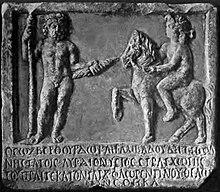Iambadoule

Iambadoule is a Thracian goddess, epigraphically testified together with the Thracian god Zberthourdos (Sbelsurdos).
Epigraphy
[edit]The deity is attested in an inscription written in Ancient Greek. A male deity, identified as Zberthourdos, is standing unclothed with a naked woman on a horse by his side.[1][2]
- θεῷ Ζβερθούρδῳ καὶ Ἰαμβαδούλῃ, ἐπιφανηστάτοις, Αὐρ(ήλιος) Διονύσιος, στρατ(ιώτης) χῶρτις τοῦ πραιτ(ωρίου) ἑκατοντάρχ(ου) Φλωρεντίνου, θέλων ἀνέθηκα
Translation:
- To God Zberthourdos and Iambadoule, the most prominent, Aurelius Dionysius, a local soldier of the praetorian centurion Florentinus, wished to dedicate.
According to Dimitar Detschew, the form Ἰαμβαδούλῃ appears in the dative, pointing to a nominative Ἰαμβαδούλῃ (Iambadoule) or Ἰαμβαδούλῃς (Iambadoules).[3]
Etymology
[edit]French archeologist Paul Perdrizet indicated that the particle "-δουλέ" is also attested in personal name Δουλέ-ζελμις, a Thracian mercenary.[4]
Detschew suggested that the deity's name is an epithet of a Thracian earth-mother goddess, translated as "the one that places the grain", with "iamba" meaning "wheat; wealthy, nutrition", and "doule" from Proto-Indo-European *dhe- 'to place', plus nomen agentis suffix -lo.[5]
Bulgarian linguist Vladimir I. Georgiev proposed that Iambadoules means 'rainstorm, thunderstorm', from Dula 'the storm',[6] with relation to Old Iranian ambhas 'water' and Greek θύελλα (thúella) 'storm'.[7]
Legacy
[edit]According to researcher Dragoslav Antonijević, Dragojlovic argued that the South Slavic character of the samovila (a fairy-like figure) is a continuation of this Thracian goddess.[8]
References
[edit]- ^ Perdrizet, Paul [in French] (1899). "Le dieu Thrace Zbelthiourdos". Revue des Études Anciennes. 1 (1): 24. doi:10.3406/rea.1899.1123.
- ^ Bellon, Tiffany (2019). "Migration et appartenance(s). Le cas des Thraces à Rome (Ier-IIIe siècles apr. J.-C.)". Revue belge de philologie et d'histoire (in French). 97 (1): 151. doi:10.3406/rbph.2019.9262.
- ^ Detschev, Dimitar (1952). "Une triade familiale, dans la religion des Thraces". Bulletin de l'Institut archéologique (in Bulgarian). 18: 50.
- ^ Perdrizet, Paul [in French] (1899). "Le dieu Thrace Zbelthiourdos". Revue des Études Anciennes. 1 (1): 25. doi:10.3406/rea.1899.1123.
- ^ Detschev, Dimitar (1952). "Une triade familiale, dans la religion des Thraces". Bulletin de l'Institut archéologique (in Bulgarian). 18: 51.
- ^ Georgiev, Vladimir I.. "Thrakisch und Dakisch". Band 29/2. Teilband Sprache und Literatur (Sprachen und Schriften [Forts.]), edited by Wolfgang Haase, Berlin, Boston: De Gruyter, 1983. p. 1210. doi:10.1515/9783110847031-016
- ^ Georgiev, Vladimir I.. "Thrakisch und Dakisch". Band 29/2. Teilband Sprache und Literatur (Sprachen und Schriften [Forts.]), edited by Wolfgang Haase, Berlin, Boston: De Gruyter, 1983. p. 1168. doi:10.1515/9783110847031-015
- ^ Antonijević, Dragoslav. "A Contribution to the Study of the Folklore Ritual Substratum in the Balkans". In: Balcanica: annuaire de l'Institut des études balkaniques, 1983, 13-14 (1982-1983), pp. 416-417.
Further reading
[edit]- Vlahov, K. (1980). "Die thrakischen Gottheiten Zberthourdos, Iambadoula und Asdoula". Bulgarian Historical Review (in German). 8: 90–96.
Text is available under the CC BY-SA 4.0 license; additional terms may apply.
Images, videos and audio are available under their respective licenses.
